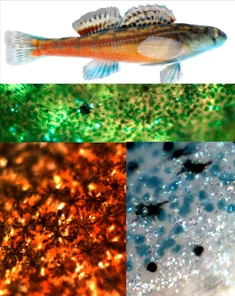Sensory EcologyThis line of research contributes to a comprehensive understanding of how visual ecology influences sexually selected traits in freshwater fishes. Work in this area includes examining the following major topics:
1) Visual systems of freshwater fishes Interpreting visual signals relies upon an understanding of the corresponding visual system. A recent study, the first study to describe the visual system of 7 species of darters (genus Etheostoma), suggests that darters are dichromatic, with two morphologically and spectrally distinct cone photoreceptors (Gumm et al., 2012). There were differences between species and between individuals in spectral sensitivity, suggesting that species may be adapted for different light environments (Gumm et al. 2012). We are currently examining how structural (i.e. changes in amino acid sequences) and regulatory (i.e. changes in gene expression) genetic changes contribute to divergence in visual systems in darters and other freshwater fish systems. 2) Function of coloration In darters, female preferences for color lead to reproductive isolation between species, but mate preferences for coloration within a species remain unclear. We recently examined this question by testing if female Etheostoma barrenense prefer variants of red coloration, which may indicate male quality (Williams, Gumm et al. 2013). In an additional study, the first study of mate preferences in fishes of the genus Percina, we found that females do not prefer males that are larger or have more coloration (Ciccotto, Gumm, & Mendelson, 2014). We have also recently found that males also express visual preferences for certain females (Ciccotto, Gumm, & Mendelson, 2013). 3) The evolution of coloration Quantitative analysis of male nuptial coloration in darters revealed differences in spectral properties within color classes among species (Gumm et al. 2011). Combining reflectance spectrophotometry with comparative phylogenetic methods, we found that coloration has high evolutionary lability, suggesting that color may be influenced by ecological factors that are not phylogenetically conserved. Further, coloration on different body areas is evolving independently (Gumm & Mendelson 2011). Thus, different selective pressures may influence the evolution of coloration on different body areas. We are continuing to examine the mechanisms of coloration by exploring the pigments that contribute to coloration in darters. |
Species interactions and conservationStudents in the lab are currently examining questions at the intersection of animal behavior, evolutionary ecology and conservation. Understanding the behavioral aspects of conservation problems can help inform more effective management solutions. One major concern in conservation biology is invasive species. Social interactions between invasive and endemic species may directly contribute to the negative effects of invasive species. The lab is currently funded by the Texas Parks and Wildlife Department to examine population genetics and behavioral ecology relating to hybridization between an invasive (Sheepshead minnow, Cyprinodon variegatus) and native pupfish (Red River pupfish, C. rubrofluviatilis). For hybridization to occur, reproductive isolating mechanisms must be incomplete. Recent graduate student, Cory Becher, tested if female mate preference or male-male competition inhibit or facilitate hybridization between C. variegatus and C. rubrofluviatilis. Another graduate student, Chandler Brooks, examined social interactions between these two species at the population level. Males of many pupfish species are territorial and exhibit 'dear enemy' recognition, where territorial males are less aggressive to neighboring males than to other intruders. Chandler's work compared 'dear enemy' recognition between species and in mixed species groups. Their results will provide critical information about how these species interact upon secondary contact, allow us to make predictions about how hybridization and introgression may progress and may ultimately inform management actions.
Work on this system is ongoing so stay tuned for more info! We have also examined how predator-prey interactions influence reproductive behavior. Examining interspecific dynamics in a desert spring system in West Texas, we established that an endangered egg predator, Gambusia nobilis altered breeding behavior and contributed to the decline of the endangered Leon Springs pupfish, Cyprinodon bovinus (Gumm et al. 2008). Habitat restoration resulted in decreased egg predation pressure and a corresponding resurgence in the pupfish population (Gumm et al., 2011). Direct conflicts between multiple endangered species present unique challenges to conservation and, this was the first example of effective management of deleterious interactions between two endangered species using habitat restoration. |
Ecology of mating behaviorWithin a population, the social environment also has important consequences for individual reproductive behavior and fitness. In the endangered Comanche Springs pupfish, C. elegans, males express one of three alternative reproductive tactics (ARTs); territoriality, satellite behavior, or female mimicry. Field studies established that population composition facilitates spawning by female mimics in the natural population (Gumm 2009). Additionally, territorial males’ aggression towards female mimics is dependent on local social environments (Gumm, 2012). Using behavioral and genetic methods in a laboratory study, I directly tested the fundamental relationship between ecological, demographic variables and evolutionary processes (i.e. sexual selection) by quantifying the fitness outcomes of males expressing ARTs. Population density and sex ratio influenced aggressive behavior and reproductive success of males expressing different tactics (Gumm 2009). The differences in relative fitness among males expressing ARTs suggest that demographic factors influence the strength of sexual selection and that dynamic social environments may have played a role in the evolution of or continued maintenance of ARTs in this system. Understanding how the social environment mediates variation in reproductive success and even population size, is critically important for successful management of this and other pupfish species.
|








